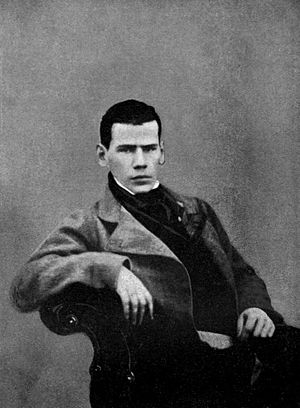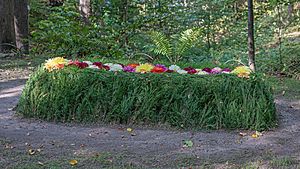Leo Tolstoy facts for kids
Quick facts for kids
Leo Tolstoy
|
|
|---|---|
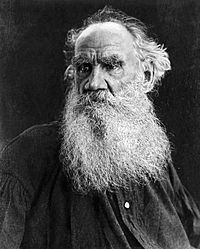
Tolstoy on 23 May 1908 at Yasnaya Polyana, four months before his 80th birthday.
|
|
| Native name |
Лев Николаевич Толстой
|
| Born | Lev Nikolaevich Tolstoy 9 September 1828 Yasnaya Polyana, Tula Governorate, Russian Empire |
| Died | 20 November 1910 (aged 82) Astapovo, Ryazan Governorate, Russian Empire |
| Resting place | Yasnaya Polyana |
| Occupation | Novelist, short story writer, playwright, essayist |
| Language | Russian |
| Nationality | Russian |
| Period | 1847–1910 |
| Literary movement | Realism |
| Notable works | War and Peace Anna Karenina The Death of Ivan Ilyich The Kingdom of God Is Within You Resurrection |
| Spouse | |
| Children | 14 |
|
|
|
| Signature | |
Count Lev Nikolayevich Tolstoy (9 September 1828 – 20 November 1910) was a Russian novelist and anarchist, famous for writing the books War and Peace and Anna Karenina, and many other works. He was a Christian and believed in non-violence. His work The Kingdom of God is within you has influenced people like Mahatma Gandhi and Martin Luther King.
Life and career
Tolstoy was born at Yasnaya Polyana, a family estate 12 kilometres (7.5 mi) southwest of Tula, and 200 kilometres (120 mi) south of Moscow. He was the fourth of five children of Count Nikolai Ilyich Tolstoy (1794–1837), a veteran of the Patriotic War of 1812, and Princess Mariya Tolstaya (née Volkonskaya; 1790–1830). His mother died when he was two and his father when he was nine. Tolstoy and his siblings were brought up by relatives. In 1844, he began studying law and oriental languages at Kazan University, where teachers described him as "both unable and unwilling to learn". Tolstoy left the university in the middle of his studies, returned to Yasnaya Polyana and then spent much time in Moscow, Tula and Saint Petersburg, leading a lax and leisurely lifestyle. He began writing during this period, including his first novel Childhood, a fictitious account of his own youth, which was published in 1852. In 1851, after running up heavy gambling debts, he went with his older brother to the Caucasus and joined the army. Tolstoy served as a young artillery officer during the Crimean War and was in Sevastopol during the 11-month-long siege of Sevastopol in 1854–55, including the Battle of the Chernaya. During the war he was recognised for his courage and promoted to lieutenant. He was appalled by the number of deaths involved in warfare, and left the army after the end of the Crimean War.
His experience in the army and his European trip in 1860–61 shaped both his political and literary development. Tolstoy returned to Yasnaya Polyana and founded 13 schools for the children of Russia's peasants, who had just been emancipated from serfdom in 1861. Tolstoy described the schools' principles in his 1862 essay "The School at Yasnaya Polyana". His educational experiments were short-lived, partly due to harassment by the Tsarist secret police. However, as a direct forerunner to A.S. Neill's Summerhill School, the school at Yasnaya Polyana can justifiably be claimed the first example of a coherent theory of democratic education.
Personal life
The death of his brother Nikolay in 1860 had an impact on Tolstoy, and led him to a desire to marry. On 23 September 1862, Tolstoy married Sophia Andreevna Behrs, who was sixteen years his junior and the daughter of a court physician. She was called Sonya, the Russian diminutive of Sofia, by her family and friends. They had 13 children, eight of whom survived childhood:
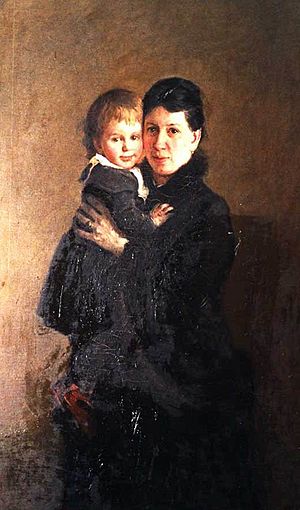
- Count Sergei Lvovich Tolstoy (1863–1947), composer and ethnomusicologist
- Countess Tatyana Lvovna Tolstaya (1864–1950), wife of Mikhail Sergeevich Sukhotin
- Count Ilya Lvovich Tolstoy (1866–1933), writer
- Count Lev Lvovich Tolstoy (1869–1945), writer and sculptor
- Countess Maria Lvovna Tolstaya (1871–1906), wife of Nikolai Leonidovich Obolensky
- Count Peter Lvovich Tolstoy (1872–1873), died in infancy
- Count Nikolai Lvovich Tolstoy (1874–1875), died in infancy
- Countess Varvara Lvovna Tolstaya (1875–1875), died in infancy
- Count Andrei Lvovich Tolstoy (1877–1916), served in the Russo-Japanese War
- Count Michael Lvovich Tolstoy (1879–1944)
- Count Alexei Lvovich Tolstoy (1881–1886)
- Countess Alexandra Lvovna Tolstaya (1884–1979)
- Count Ivan Lvovich Tolstoy (1888–1895)
The couple's early married life was happy and allowed Tolstoy much freedom and the support system to compose War and Peace and Anna Karenina with Sonya acting as his secretary, editor, and financial manager. Sonya was copying and hand-writing his epic works time after time. Tolstoy would continue editing War and Peace and had to have clean final drafts to be delivered to the publisher.
However, their later life together has been described by A.N. Wilson as one of the unhappiest in literary history. Tolstoy's relationship with his wife deteriorated as his beliefs became increasingly radical. This saw him seeking to reject his inherited and earned wealth, including the renunciation of the copyrights on his earlier works.
Some members of the Tolstoy family left Russia in the aftermath of the 1905 Russian Revolution, or after the establishment of the Soviet Union following the 1917 October Revolution, and many of Leo Tolstoy's relatives and descendants today live in Sweden, Germany, the United Kingdom, France and the United States. Tolstoy's son, Count Lev Lvovich Tolstoy, settled in Sweden and married a Swedish woman. Leo Tolstoy's last surviving grandchild, Countess Tatiana Tolstoy-Paus, died in 2007 at Herresta manor in Sweden, which is owned by Tolstoy's descendants. Swedish jazz singer Viktoria Tolstoy is also descended from Leo Tolstoy.
One of his great-great-grandsons, Vladimir Tolstoy (born 1962), has been a director of the Yasnaya Polyana museum since 1994 and an adviser to the President of Russia on cultural affairs since 2012. Ilya Tolstoy's great-grandson, Pyotr Tolstoy, is a well-known Russian journalist and TV presenter as well as a State Duma deputy since 2016. His cousin Fyokla Tolstaya (born Anna Tolstaya in 1971), daughter of the acclaimed Soviet Slavist Nikita Tolstoy (ru) (1923–1996), is also a Russian journalist, TV and radio host.
Novels and fictional works
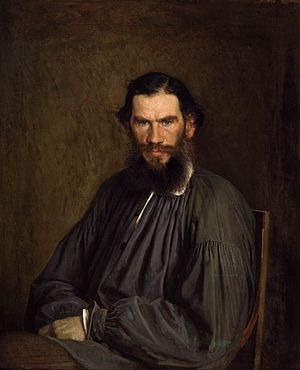
Tolstoy is considered one of the giants of Russian literature; his works include the novels War and Peace and Anna Karenina and novellas such as Hadji Murad and The Death of Ivan Ilyich.
His fiction consistently attempts to convey realistically the Russian society in which he lived. The Cossacks (1863) describes the Cossack life and people through a story of a Russian aristocrat in love with a Cossack girl. Anna Karenina (1877) tells parallel stories of a woman trapped by the conventions and falsities of society and of a philosophical landowner (much like Tolstoy), who works alongside the peasants in the fields and seeks to reform their lives. Tolstoy not only drew from his own life experiences but also created characters in his own image, such as Pierre Bezukhov and Prince Andrei in War and Peace, Levin in Anna Karenina and to some extent, Prince Nekhlyudov in Resurrection.
War and Peace is generally thought to be one of the greatest novels ever written, remarkable for its dramatic breadth and unity. Its vast canvas includes 580 characters, many historical with others fictional. The story moves from family life to the headquarters of Napoleon, from the court of Alexander I of Russia to the battlefields of Austerlitz and Borodino. Tolstoy's original idea for the novel was to investigate the causes of the Decembrist revolt, to which it refers only in the last chapters, from which can be deduced that Andrei Bolkonsky's son will become one of the Decembrists. The novel explores Tolstoy's theory of history, and in particular the insignificance of individuals such as Napoleon and Alexander. Somewhat surprisingly, Tolstoy did not consider War and Peace to be a novel (nor did he consider many of the great Russian fictions written at that time to be novels). This view becomes less surprising if one considers that Tolstoy was a novelist of the realist school who considered the novel to be a framework for the examination of social and political issues in nineteenth-century life. War and Peace (which is to Tolstoy really an epic in prose) therefore did not qualify. Tolstoy thought that Anna Karenina was his first true novel.
After Anna Karenina, Tolstoy concentrated on Christian themes. In his novel Resurrection, Tolstoy attempts to expose the injustice of man-made laws and the hypocrisy of an institutionalized church.
Tolstoy also tried writing poetry, with several soldier songs written during his military service, and fairy tales in verse such as Volga-bogatyr and Oaf stylized as national folk songs. They were written between 1871 and 1874 for his Russian Book for Reading, a collection of short stories in four volumes (total of 629 stories in various genres) published along with the New Azbuka textbook and addressed to schoolchildren. Nevertheless, he was skeptical about poetry as a genre. As he famously said, "Writing poetry is like ploughing and dancing at the same time." According to Valentin Bulgakov, he criticised poets, including Alexander Pushkin, for their "false" epithets used "simply to make it rhyme."
Death
Tolstoy died on 20 November 1910 at the age of 82. Just before his death, his health was a concern of his family, who cared for him daily. In his last days, he spoke and wrote about dying. Renouncing his aristocratic lifestyle, he left home one winter night. His secretive departure was an apparent attempt to escape from his wife's tirades. She spoke out against many of his teachings.
Tolstoy died of pneumonia at Astapovo railway station, after a day's train journey south. The station master took Tolstoy to his apartment.
The police tried to limit access to his funeral procession, but thousands of peasants lined the streets. Still, some were heard to say that other than knowing that "some nobleman had died", they knew little else about Tolstoy.
According to some sources, Tolstoy spent the last hours of his life preaching love and non-violence to fellow passengers on the train.
Images for kids
-
Statue of Tolstoy in Castlegar, British Columbia
-
Bust of Tolstoy in Montevideo, Uruguay
See also
 In Spanish: León Tolstói para niños
In Spanish: León Tolstói para niños


